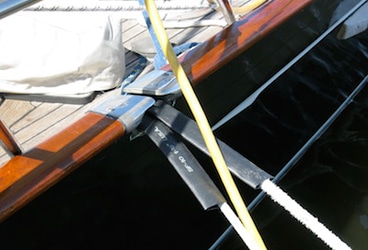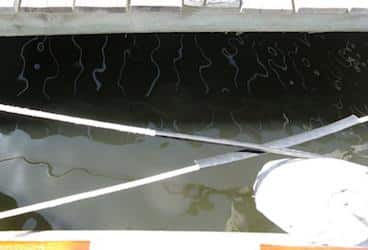
Chafe gear
Chafe gear is a critical part of keeping your boat safe, but rarely does it receive much attention. Who cares about chafe gear? You should! After ground tackle, chafe gear is one of the best insurance investments for your boat. Plus chafe gear is not just for at the dock.
When we were originally shopping for chafe gear, we followed Practical Sailor’s recommendations and bought a product called “ultra chafe gear,” but it’s so rigid and stiff, that it’s difficult to work with. Plus it won’t fit through any of our chocks. As a result, we use it only for lines that might chafe against the dock. Since then we’ve added a variety of different types of chafe gear. It seems anytime we find a new location that needs chafe gear, we acquire something different—everything from fire hose, to garden hose, to bicycle-tire inner tube.
So what should you look for in chafe gear?
First, take a good long look at your boat and note any place a line could rub. When lines rub anything (even each other), chafe is a possibility, maybe even a probability. Make a list. Where do dock lines touch anything? For example, chocks, over the edge of the dock, or around a piling. And don’t just look for places lines touch while you’re at the dock. What about when you’re at anchor? And what about attached to a mooring ball?
Now that you have a list of all the places lines could potentially rub and chafe, you’ll need to know what size line is in each place. And also, what size the fitting is that it will be going through, if any—chocks are a prime example. Once you know the line size and size of chock, then begin looking around for chafe gear.

4 Things to Look For In Chafe Gear
1. Is the chafe gear sturdy enough to stand up to whatever rubbing and chafe it might encounter? Think BIG STORM, lots of boat motion and lines rubbing a great deal, not just ordinary tide swings, although that’s important too. So, for places the lines might saw back and forth over a ragged edge (dock?) use heavier, sturdier chafe gear. For places where lines have to bend through chocks, use a lighter more flexible chafe gear—or make sure the chocks are totally smooth and have no chafe potential—although we prefer to use chafe guards through our chocks just in case.
2. Is the chafe gear long enough to still be protecting the line when things are in motion?
3. Will the chafe gear fit wherever you want the protection? The sturdiest fire hose in the world won’t help if it won’t fit to protect the line—mostly this involves fitting it through chocks on your boat.
4. Is there a way to KEEP the chafe gear in place? This is critical—chafe gear isn’t useful if it slides out of place—and thus no longer protects against rubbing and chafe. Usually we can add a small line to each end and tie it securely around the line to keep the chafe gear in place.
Our Choices
Keep in mind, I mentioned we have a hodgepodge of chafe gear—right now we’re still using the heavy duty red rubber chafe gear recommended years ago by Practical Sailor for edges of docks, around pilings, or anywhere we can use heavy-duty totally inflexible and huge-diameter chafe gear.
Our “go-to” chafe gear at the moment is something we bought at a nautical resale shop. It’s black, hard rubber or plastic, a bit flexible, and fits through our chocks. We also have some bicycle-tire inner tube that’s very flexible but not nearly as durable and wears out quickly. We also have some West Marine chafe gear (the leather version and the heavy canvas).
How to Use Garden Hose or Other Hose
Hose is obviously totally circular, so there’s no open side to slide the line into. If at all possible, we prefer to slide it over the line from the end but you can also slit it lengthwise with a knife, position it over the line where you want it and then tie it on with small line.
Dockside Isn’t The Only Challenge…
Lines can chafe in a variety of positions, even running rigging, although that’s tough to guard against other than to watch it and replace worn lines. We have a roller-furling line that’s chafing, so we’ll need to replace it when we return to the boat this fall. Take a look around your boat and see if you can spot any other areas that lines might be chafing. Be sure to look carefully at mooring line chafe and ground tackle chafe.
If you have other possibilities, be sure to address them ahead of time, not when you’re staring at one end of a chafed line and hopefully not adrift! Do you have another favorite type of chafe gear? Do you have other places you use it? Please leave a comment and share.
Jan Irons and her husband, David, cruise part of the year aboard Winterlude, their Passport 37. Her website Commuter Cruiser provides info about part-time cruising, including basic principles that will allow you to overcome the natural aversion to leaving your floating home in an unfamiliar location and entrusting it to people you do not know. Jan is also the co-author of The Boat Galley Cookbook, due to be released this fall from International Marine.








